Although the sub-literate frequently battle it out on television for the sick amusement of condescending (yet paradoxically celebrating) audiences everywhere, some of the world’s most fascinating fights occur in far more intellectual arenas. Feuds — whether they occur on campus or in coldly calculated "entertainment" — fundamentally pique the very same emotions and frequently petty actions in the smart and stupid alike. The main difference between fluorescent orange morons and feuds between artists, scientists, authors and other thinkers is pretty straightforward, though. When it comes to the latter demographics, discourse furthers, and history (and occasionally progress) ends up made. Stimulating debates and even admittedly amusing debacles between big brains and influential intellectuals occur daily — they just don’t receive any real coverage. The following, however, somehow managed to receive a right fair amount of attention, for better or for worse. And, of course, ended up shaping the course of science and/or their respective creative pursuits forever.
-
Freud vs. Jung
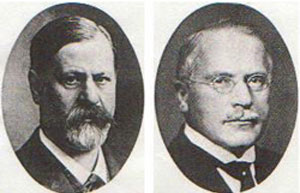 Probably one of the most famous rivalries in all of "Western" philosophy and science, Sigmund Freud started out as one of Carl Jung’s most beloved mentors before their close relationship soured. Now considered psychoanalysis’ two daddies, the intellectual juggernauts split mainly because of one massive disagreement — specifically, regarding the human unconscious. Jung didn’t believe his veritable Mr. Miyagi of all things psychological took it seriously enough. Their theories about suppressed and repressed thoughts and emotions lurking in the unconscious existed in harmony, but once Jung proposed the collective unconscious, everything began unraveling. His mentor proposed a structure involving some degree of collectivism, of course, though Jung considered it far bigger and more significant. Freud, on the other hand, saw the unconscious as a supplement to the overall psyche rather than its own unique, influential entity.
Probably one of the most famous rivalries in all of "Western" philosophy and science, Sigmund Freud started out as one of Carl Jung’s most beloved mentors before their close relationship soured. Now considered psychoanalysis’ two daddies, the intellectual juggernauts split mainly because of one massive disagreement — specifically, regarding the human unconscious. Jung didn’t believe his veritable Mr. Miyagi of all things psychological took it seriously enough. Their theories about suppressed and repressed thoughts and emotions lurking in the unconscious existed in harmony, but once Jung proposed the collective unconscious, everything began unraveling. His mentor proposed a structure involving some degree of collectivism, of course, though Jung considered it far bigger and more significant. Freud, on the other hand, saw the unconscious as a supplement to the overall psyche rather than its own unique, influential entity.
-
Tesla vs. Edison
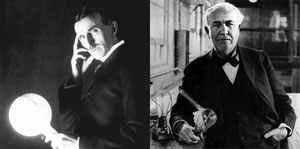 "The War of Currents" still resonates today, as the world’s infrastructure still volleys between AC and DC. And it all started with a famous feud between slimeball supreme Thomas Edison and super sexy Nikola Tesla. They debated passionately about alternating current (Tesla) and direct current (Edison) as the most efficient electrical system, eventually embroiling themselves in a very public circus of one-upsmanship. Most infamously, Edison videotaped the euthanasia of abusive Luna Park Zoo elephant Topsy as "proof" that AC was far too dangerous to implement. Beyond that, though, he simply possessed the biggest and brightest PR campaign — and Tesla’s notoriously eccentric, obsessive and highly critical behavior didn’t win him too many favors, either. Interestingly enough, though, Edison allegedly wished he had rolled with his rival towards the end of his life.
"The War of Currents" still resonates today, as the world’s infrastructure still volleys between AC and DC. And it all started with a famous feud between slimeball supreme Thomas Edison and super sexy Nikola Tesla. They debated passionately about alternating current (Tesla) and direct current (Edison) as the most efficient electrical system, eventually embroiling themselves in a very public circus of one-upsmanship. Most infamously, Edison videotaped the euthanasia of abusive Luna Park Zoo elephant Topsy as "proof" that AC was far too dangerous to implement. Beyond that, though, he simply possessed the biggest and brightest PR campaign — and Tesla’s notoriously eccentric, obsessive and highly critical behavior didn’t win him too many favors, either. Interestingly enough, though, Edison allegedly wished he had rolled with his rival towards the end of his life.
-
Lewis vs. Tolkien
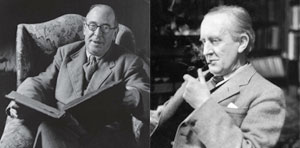 C.S. Lewis and J.R.R. Tolkien probably comprise one of the literary world’s most famous bromances, but they also experienced a falling out as epic as their landmark fantasy series. To put it bluntly, The Lord of the Rings scribe Tolkien never much cared for Lewis’ The Chronicles of Narnia novels — or his theological leanings. Both Oxford Inklings adhered to Christianity, though completely different denominations. Former atheist Lewis converted to Anglicanism, while Tolkien remained Catholic. And right there, one can probably start assuming where the cracks in their relationship started forming. Tolkien believed that Lewis’ writings took on an anti-Catholic vibe as he grew more and more enthralled with Protestantism — culminating in his use of the religious slur "papists." When it came to infusing Christian themes into their fiction, the formerly dynamic duo also came to intellectual blows. The Chronicles of Narnia prominently featured some obvious symbols, while The Lord of the Rings trilogy featured them in a far more subdued manner.
C.S. Lewis and J.R.R. Tolkien probably comprise one of the literary world’s most famous bromances, but they also experienced a falling out as epic as their landmark fantasy series. To put it bluntly, The Lord of the Rings scribe Tolkien never much cared for Lewis’ The Chronicles of Narnia novels — or his theological leanings. Both Oxford Inklings adhered to Christianity, though completely different denominations. Former atheist Lewis converted to Anglicanism, while Tolkien remained Catholic. And right there, one can probably start assuming where the cracks in their relationship started forming. Tolkien believed that Lewis’ writings took on an anti-Catholic vibe as he grew more and more enthralled with Protestantism — culminating in his use of the religious slur "papists." When it came to infusing Christian themes into their fiction, the formerly dynamic duo also came to intellectual blows. The Chronicles of Narnia prominently featured some obvious symbols, while The Lord of the Rings trilogy featured them in a far more subdued manner.
-
Marquez vs. Llosa
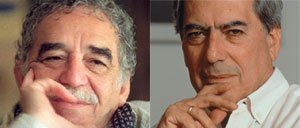 The super scandalous feud between Mario Vargas Llosa and Gabriel Garcia Marquez lasted a staggering three decades — although the former penned a prologue for the 40th edition of the latter’s One Hundred Years of Solitude. Some take this as a sign of resolution at last, while others aren’t terribly sure. What literary types and historians do know, however, is that their once deep and profound relationship ended when Vargas Llosa decked Marquez in the eye at a movie premiere. According to their mutual friend Rodrigo Moya, who famously photographed the Colombian author’s massive shiner, a woman broke them up. Both writers and their wives understandably continue remaining wholly mum on the subject. But Moya insists that Llosa’s dalliance with a fetching Swede and Marquez’s advice that his wife for divorce instigated the violent display and subsequent silence. Much like how many licks it takes to get to the Tootsie Roll center of a Tootsie Pop, the world may never know.
The super scandalous feud between Mario Vargas Llosa and Gabriel Garcia Marquez lasted a staggering three decades — although the former penned a prologue for the 40th edition of the latter’s One Hundred Years of Solitude. Some take this as a sign of resolution at last, while others aren’t terribly sure. What literary types and historians do know, however, is that their once deep and profound relationship ended when Vargas Llosa decked Marquez in the eye at a movie premiere. According to their mutual friend Rodrigo Moya, who famously photographed the Colombian author’s massive shiner, a woman broke them up. Both writers and their wives understandably continue remaining wholly mum on the subject. But Moya insists that Llosa’s dalliance with a fetching Swede and Marquez’s advice that his wife for divorce instigated the violent display and subsequent silence. Much like how many licks it takes to get to the Tootsie Roll center of a Tootsie Pop, the world may never know.
-
Michelangelo vs. Julius II
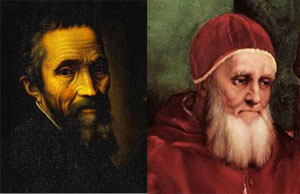 Unlike some of the other feuds listed here, the one between Pope Julius II and brilliant Renaissance man Michelangelo di Lodovico Buonarroti Simoni consistently yo-yoed back and forth between amicability and severity. The pontiff adored the artist’s work and served as one of his most ardent — and infamous! — benefactors. For 40 years, Michelangelo struggled to design Julius II’s grandiose tomb, but the Sistine Chapel remains the pair’s most notable achievement. And, of course, the one sparking the most discord between them. Michelangelo’s notorious temper and perfectionism overtook him on more than one occasion, leading the pair to argue viciously over the remarkable frescoes. Perceptions over progress, for the most part, came between them. Julius II often tried to coax his client to work faster, even after he had already dismissed his staff and resigned himself to painting alone. Adding to the mounting inter- and intrapersonal stress was the fact that Michelangelo often lamented fresco commissions. He fancied himself a sculptor above all else and mourned anything preempting that, including what many art historians and buffs consider his magnum opus.
Unlike some of the other feuds listed here, the one between Pope Julius II and brilliant Renaissance man Michelangelo di Lodovico Buonarroti Simoni consistently yo-yoed back and forth between amicability and severity. The pontiff adored the artist’s work and served as one of his most ardent — and infamous! — benefactors. For 40 years, Michelangelo struggled to design Julius II’s grandiose tomb, but the Sistine Chapel remains the pair’s most notable achievement. And, of course, the one sparking the most discord between them. Michelangelo’s notorious temper and perfectionism overtook him on more than one occasion, leading the pair to argue viciously over the remarkable frescoes. Perceptions over progress, for the most part, came between them. Julius II often tried to coax his client to work faster, even after he had already dismissed his staff and resigned himself to painting alone. Adding to the mounting inter- and intrapersonal stress was the fact that Michelangelo often lamented fresco commissions. He fancied himself a sculptor above all else and mourned anything preempting that, including what many art historians and buffs consider his magnum opus.
-
Oppenheimer vs. Teller
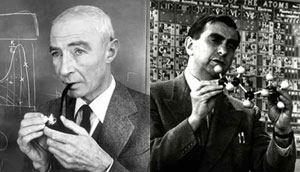 It takes some serious scientific guts to go up against one of the era’s most prodigious, prolific minds and label him a security risk. Whether one agrees with his accusations or not, Edward Teller certainly possessed them. J. Robert Oppenheimer headed up Los Alamos and the Manhattan Project and served as an advisor to the Atomic Energy Commission before the Red Scare eventually got to him. In 1954, he ended up in front of the AEC Personnel Security Board under accusations of affiliating with the Communist Party. He had, actually, back in the 1930s. But former colleague Edward Teller played one of the most significant roles in sealing Oppenheimer’s ultimate loss. They worked together at Los Alamos and the Manhattan Project, often arguing about fusion, fission and everything else related to the hydrogen bomb. When the AEC called Teller in for questioning, he quickly complimented his superior’s leadership acumen and keen scientific mind. After that, though, he made it no secret that he perceived Oppenheimer’s former communist affiliation compromised his loyalty. To this day, Teller’s testimonial elicits controversy amongst historians and scientists alike, who still argue over whether the Manhattan Project poster boy genuinely posed a serious threat to Americans or merely ended up an unfortunate intellectual "casualty" to McCarthyism.
It takes some serious scientific guts to go up against one of the era’s most prodigious, prolific minds and label him a security risk. Whether one agrees with his accusations or not, Edward Teller certainly possessed them. J. Robert Oppenheimer headed up Los Alamos and the Manhattan Project and served as an advisor to the Atomic Energy Commission before the Red Scare eventually got to him. In 1954, he ended up in front of the AEC Personnel Security Board under accusations of affiliating with the Communist Party. He had, actually, back in the 1930s. But former colleague Edward Teller played one of the most significant roles in sealing Oppenheimer’s ultimate loss. They worked together at Los Alamos and the Manhattan Project, often arguing about fusion, fission and everything else related to the hydrogen bomb. When the AEC called Teller in for questioning, he quickly complimented his superior’s leadership acumen and keen scientific mind. After that, though, he made it no secret that he perceived Oppenheimer’s former communist affiliation compromised his loyalty. To this day, Teller’s testimonial elicits controversy amongst historians and scientists alike, who still argue over whether the Manhattan Project poster boy genuinely posed a serious threat to Americans or merely ended up an unfortunate intellectual "casualty" to McCarthyism.
-
Franklin vs. Watson, Wilkins and Crick
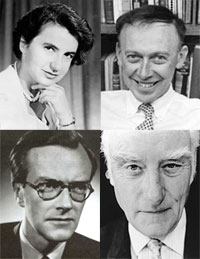 Historically, female scientists haven’t exactly enjoyed nearly as much recognition as they deserve, even watching many of their male contemporaries outright steal their research — and many academics and professionals point towards Rosalind Franklin as one of the most sterling examples. She photographed the structure later identified as DNA back in 1953 while working with Maurice Wilkins, who treated her as an assistant rather than his intellectual equal. Despite this sadly common attitude, Franklin continued generating earth-shattering research, which Wilkins, James D. Watson and Francis Crick used to discover DNA’s double helix shape. The trio eventually won Nobel Prizes for their achievement, but almost no credit went towards the woman upon whose oeuvre they built it. She actually passed from ovarian cancer a few years prior, which rendered her unable to fight against the subsequent obscurity. Plenty of feminists and fellow scientists (both male and female), however, have taken it up and continue to debate by proxy.
Historically, female scientists haven’t exactly enjoyed nearly as much recognition as they deserve, even watching many of their male contemporaries outright steal their research — and many academics and professionals point towards Rosalind Franklin as one of the most sterling examples. She photographed the structure later identified as DNA back in 1953 while working with Maurice Wilkins, who treated her as an assistant rather than his intellectual equal. Despite this sadly common attitude, Franklin continued generating earth-shattering research, which Wilkins, James D. Watson and Francis Crick used to discover DNA’s double helix shape. The trio eventually won Nobel Prizes for their achievement, but almost no credit went towards the woman upon whose oeuvre they built it. She actually passed from ovarian cancer a few years prior, which rendered her unable to fight against the subsequent obscurity. Plenty of feminists and fellow scientists (both male and female), however, have taken it up and continue to debate by proxy.
-
Dawkins vs. God
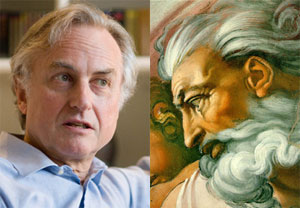 The God Delusion switched mainstream perceptions of Richard Dawkins from the world’s most preeminent evolutionary biologist to its most vocal proponent of atheism — although, honestly, it wouldn’t anyone at all hurt to paint him as both. The Richard Dawkins Foundation for Reason and Science and the Out Campaign were both founded to promote…well…reason and science, with the particular hope of persuading humanity away from intelligent design. Suffice to say, he’s not exactly a fan of Stephen Jay Gould’s theory of nonoverlapping magisteria! Even amongst fellow atheists and scientists, he elicits considerable criticism, with many labeling him "militant" (a word Dawkins enthusiastically embraces) and pointing out parallels between his rhetoric and that frequently wielded by religious extremists. Most fascinatingly, the Oxford Fellow and Vice President of the British Humanist Association considers himself "culturally Christian."
The God Delusion switched mainstream perceptions of Richard Dawkins from the world’s most preeminent evolutionary biologist to its most vocal proponent of atheism — although, honestly, it wouldn’t anyone at all hurt to paint him as both. The Richard Dawkins Foundation for Reason and Science and the Out Campaign were both founded to promote…well…reason and science, with the particular hope of persuading humanity away from intelligent design. Suffice to say, he’s not exactly a fan of Stephen Jay Gould’s theory of nonoverlapping magisteria! Even amongst fellow atheists and scientists, he elicits considerable criticism, with many labeling him "militant" (a word Dawkins enthusiastically embraces) and pointing out parallels between his rhetoric and that frequently wielded by religious extremists. Most fascinatingly, the Oxford Fellow and Vice President of the British Humanist Association considers himself "culturally Christian."
No deity, past, present or future, has yet to comment on the subject at this time.
No comments:
Post a Comment